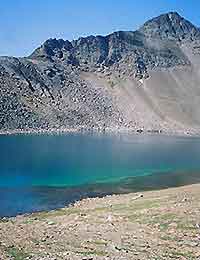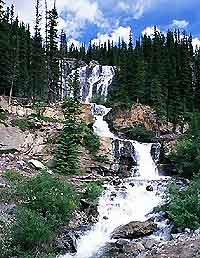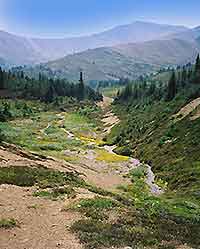Jasper History Facts and Timeline
(Jasper, Alberta, Canada)

Set at the heart of the UNESCO-designated Canada Rocky Mountain World Heritage site, Jasper lies surrounded by some of the most spectacular natural beauty in North America.
Glacier-fed lakes, towering snow-clad peaks, pristine evergreen forests, delicate protected ecosystems, wild rivers and waterfalls are its neighbors, protected by Jasper National Park and drawing visitors to its unspoilt beauty year-round.
Early History
Spectacular Athabasca Pass, close to Jasper, has been used since pre-Christian history by the native Indian population to cross the Rocky Mountains. David Thompson, of the Northwest Company, was the first white man to tread its heights in 1811, guided by Thomas the Iroquoise.

Subsequently, the pass became part of the fur-trade route between
Oregon and Canada for more than 50 years, although the race to control the fur-rich interior and find a port in Washington State was won by New York-based fur trader John Astor. Thompson's journey was delayed by the local Picani Indians, who blocked his access to Howse Pass, thus his company lost its commercial edge to the Hudson's Bay Company.
Jasper, a small, nowadays specialised municipality with just under 5,000 permanent residents, officially came into being in 1813, when Jasper Hawes established a simple fur-trading post for the North West Company. This organization was the main rival to the famous Hudson's Bay Company. Set on the trade route between Fort Edmonton and New Caledonia (now British Columbia), it was soon taken over by the Hudson's Bay Company and remained a small fur-trading hub until the Jasper National Park was set up in 1907. The remnants of Jasper House and Henry House, the two original fur-trading posts, can still be seen.
Development
With the arrival of the Grand Trunk Pacific Railway sidings in 1911, the township of Fitzhugh was established, taking its name after the vice president of the railway. In 1912, the Canadian Northern Railway added its services and the tiny settlement was surveyed and renamed Jasper in honour of the former fur-trading post and its founder. A year later, its first major landmark, the Jasper Information Center, was built. Today, this traditional cobblestone-and-timber building is a celebrated National Historic Site.

Access by road to Edmonton, some 225 miles / 360 miles to the east, became possible by 1931, while the Icefields Parkway, linking Jasper with Banff and the
Banff National Park, 180 miles / 290 km to the south, was opened in 1940. However, by 1826, the use of the pass by fur traders was in decline. At about the same time, this little town became a destination for botanists, geologists and the first tourists to the magnificent Rocky Mountains.
For many years, this UNESCO site has been famous as a visitor destination, together with the Jasper National Park and the Columbia Icefields, with long-distance bus, train and air connections serving Jasper from
Vancouver,
Edmonton and
Banff, and the modern Yellowhead Highway, as well as the Icefields Parkway, offering two of the world's most scenic drives.
 Set at the heart of the UNESCO-designated Canada Rocky Mountain World Heritage site, Jasper lies surrounded by some of the most spectacular natural beauty in North America.
Set at the heart of the UNESCO-designated Canada Rocky Mountain World Heritage site, Jasper lies surrounded by some of the most spectacular natural beauty in North America. Subsequently, the pass became part of the fur-trade route between Oregon and Canada for more than 50 years, although the race to control the fur-rich interior and find a port in Washington State was won by New York-based fur trader John Astor. Thompson's journey was delayed by the local Picani Indians, who blocked his access to Howse Pass, thus his company lost its commercial edge to the Hudson's Bay Company.
Subsequently, the pass became part of the fur-trade route between Oregon and Canada for more than 50 years, although the race to control the fur-rich interior and find a port in Washington State was won by New York-based fur trader John Astor. Thompson's journey was delayed by the local Picani Indians, who blocked his access to Howse Pass, thus his company lost its commercial edge to the Hudson's Bay Company. Access by road to Edmonton, some 225 miles / 360 miles to the east, became possible by 1931, while the Icefields Parkway, linking Jasper with Banff and the Banff National Park, 180 miles / 290 km to the south, was opened in 1940. However, by 1826, the use of the pass by fur traders was in decline. At about the same time, this little town became a destination for botanists, geologists and the first tourists to the magnificent Rocky Mountains.
Access by road to Edmonton, some 225 miles / 360 miles to the east, became possible by 1931, while the Icefields Parkway, linking Jasper with Banff and the Banff National Park, 180 miles / 290 km to the south, was opened in 1940. However, by 1826, the use of the pass by fur traders was in decline. At about the same time, this little town became a destination for botanists, geologists and the first tourists to the magnificent Rocky Mountains.